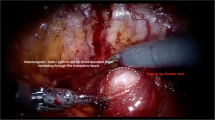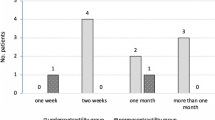Abstract
Purpose
To present the author’s experience with detrusorotomy (DM) for refractory detrusor overactivity (RDO) with open and robotic approach.
Methods
Children who underwent DM for RDO in a single surgeon series since 2012 were identified from a prospectively maintained database. Those who completed the defined strict bladder cycling regime postoperatively were included in this report excluding those who failed the bladder cycling regime.
Results
Ten children (M7: F3) were included in this report, six open and four robotic. All procedures were completed with no conversion to open in the robotic group. There were no intra or postoperative complications from the procedures. Duration of procedure was lower in robotic group (125 min) vs the open group at (208 min). Hospital stay was also lower in the robotic group (2.7 days) compared to the open group (5.6 days). All children in open group had concomitant Mitrofanoff channel created for bladder drainage. One child in robotic group had concomitant Mitrofanoff channel during DM. Median follow-up is longer at 54 months (31–82) in open group compared to 14 months (5–21). All children are clinically well with safe upper tracts on US scan in both series. Estimated % change in bladder capacity is similar in both groups at 140 (90–200) and 126 (80–200) for open and robotic groups, respectively.
Conclusions
DM as an extension of medical treatment for RDO can be performed safely and is effective in children. Preliminary experience with robotic approach to DM is promising with reduced duration of procedure and hospital stay.




Similar content being viewed by others
References
Biers SM, Venn SN, Greenwell TJ (2012) The past, present and future of augmentation cystoplasty. BJU Int 109:1280–1293. https://doi.org/10.1111/j.1464-410X.2011.10650.x
Mundy AR (1999) Metabolic complications of urinary diversion. Lancet 353:1813–1814
Stein R, Rubenwolf P (2014) Metabolic consequences after urinary diversion. Front Pediatr 2:15. https://doi.org/10.3389/fped.2014.00015
Hansen EL, Hvistendahl GM, Rawashdeh YFH, Olsen LH (2013) Promising long-term outcome of bladder autoaugmentation in children with neurogenic bladder dysfunction. J Urol. https://doi.org/10.1016/j.juro.2013.05.035
González R, Ludwikowski BM (2013) Alternatives to conventional enterocystoplasty in children: a critical review of urodynamic outcomes. Front Pediatr. https://doi.org/10.3389/fped.2013.00025
Kumar SPV, Abrams PH (2005) Detrusor myectomy: long-term results with a minimum follow-up of 2 years. BJU Int 96:341–344
Poppas DP, Uzzo RG, Britanisky RG et al (1996) Laparoscopic laser assisted auto-augmentation of the pediatric neurogenic bladder: early experience with urodynamic followup. J Urol. https://doi.org/10.1016/S0022-5347(01)66390-0
Cartwright PC, Snow BW (1989) Bladder autoaugmentation: early clinical experience. J Urol 142:505–508 (discussion 520–1)
Marte A, Di Meglio D, Cotrufo AM et al (2002) A long-term follow-up of autoaugmentation in myelodysplastic children. BJU Int. https://doi.org/10.1046/j.1464-410X.2002.02781.x
MacNeily AE, Afshar K, Coleman GU, Johnson HW (2003) Autoaugmentation by detrusor myotomy: its lack of effectiveness in the management of congenital neuropathic bladder. J Urol 170:1643–1646. https://doi.org/10.1097/01.ju.0000083800.25112.22(discussion 1646)
Gurocak S, De Gier RPE, Feitz W (2007) Bladder augmentation without integration of intact bowel segments: critical review and future perspectives. J Urol 177:839–844
Rocha FT, Bruschini H, Figueiredo JA et al (2011) Use of an inflatable silicone balloon improves the success rate of bladder autoaugmentation at long-term followup. J Urol 185:2576–2581
Djordjevic ML, Vukadinovic V, Stojanovic B et al (2015) Objective long-term evaluation after bladder autoaugmentation with rectus muscle backing. J Urol. https://doi.org/10.1016/j.juro.2014.11.081
Gamé X, Mouracade P, Chartier-Kastler E et al (2009) Botulinum toxin-A (Botox®) intradetrusor injections in children with neurogenic detrusor overactivity/neurogenic overactive bladder: a systematic literature review. J Pediatr Urol 5:156–164
Altaweel W, Jednack R, Bilodeau C, Corcos J (2006) Repeated intradetrusor botulinum toxin type A in children with neurogenic bladder due to myelomeningocele. J Urol 175:1102–1105. https://doi.org/10.1016/S0022-5347(05)00400-3
Verpoorten C, Buyse GM (2008) The neurogenic bladder: medical treatment. Pediatr Nephrol 23:717–725. https://doi.org/10.1007/s00467-007-0691-z
Lendvay TS, Cowan CA, Mitchell MM et al (2006) Augmentation cystoplasty rates at children’s hospitals in the United States: a pediatric health information system database study. J Urol 176:1716–1720. https://doi.org/10.1016/S0022-5347(06)00615-X
Author information
Authors and Affiliations
Contributions
I (RS) am the sole author for this manuscript and responsible for all aspects of this manuscript including data analysis and writing/editing.
Corresponding author
Ethics declarations
Conflict of interest
I have no disclosures and no conflict of interest.
Additional information
Publisher's Note
Springer Nature remains neutral with regard to jurisdictional claims in published maps and institutional affiliations.
Electronic supplementary material
Below is the link to the electronic supplementary material.
Supplementary material 1 (M4 V 266844 kb)
Rights and permissions
About this article
Cite this article
Subramaniam, R. Experience with detrusorotomy in children by open and robotic approach. World J Urol 38, 1869–1874 (2020). https://doi.org/10.1007/s00345-019-02777-9
Received:
Accepted:
Published:
Issue Date:
DOI: https://doi.org/10.1007/s00345-019-02777-9




